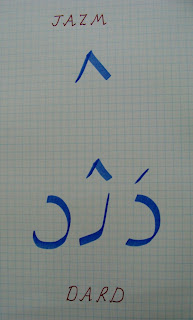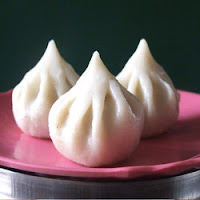The more I study Urdu, the more I fall in love with it. And mind you, in terms of knowledge, I am still in the kindergarten stage. After some thought, I have decided that it is not just the sounds which appeal to me (although, no doubt, they are most pleasing, being almost feathery, yet lambent). It is the shapes! The lines, the curves, the near-spheres, the almost-triangles! The points, oh, the points, or what are called ''nuqtaas''.
But I digress.
Since my last post (of day 38), we have moved out of the sphere of the alphabets and moved into the world of special signs. Today, it is the turn of the "jazm" (जज़्म). This is a special sign, like an inverted "V", used as a superscript. This is a sign whose use corresponds with the half-letters of Hindi/Devnaagri. It is placed over a letter to indicate that there is a quiescence or that no vowel follows the preceding consonant.
Here is how the "jazm" is written, along with a word which contains it: "dard" (which means ''pain"):
But I digress.
Since my last post (of day 38), we have moved out of the sphere of the alphabets and moved into the world of special signs. Today, it is the turn of the "jazm" (जज़्म). This is a special sign, like an inverted "V", used as a superscript. This is a sign whose use corresponds with the half-letters of Hindi/Devnaagri. It is placed over a letter to indicate that there is a quiescence or that no vowel follows the preceding consonant.
Here is how the "jazm" is written, along with a word which contains it: "dard" (which means ''pain"):
Here is a ghazal which contains the word "dard", penned by that wonderful bard, Amjad Islam Amjad:
Chaand ke saath kaii dard puraane nikale
kitne gham the jo tere gham ke bahaane nikale
Chaand ke saath kaii dard puraane nikale
kitne gham the jo tere gham ke bahaane nikale
Listen to this ghazal, rendered so wonderfully by the late Jagjit Singh:
















